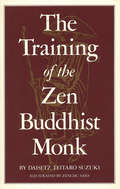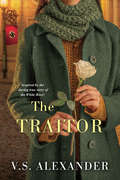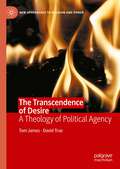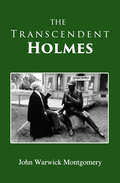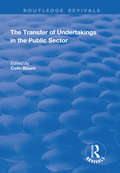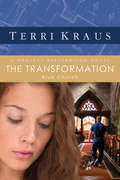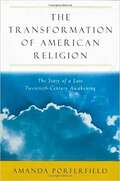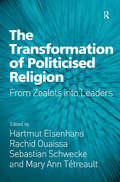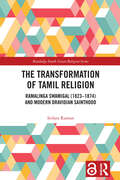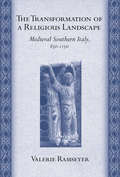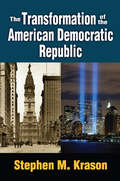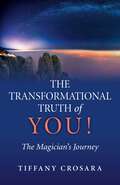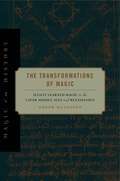- Table View
- List View
The Training & Work of an Initiate
by Dion FortuneThe Training and Work of an Initiate shows how, from ancient Qabalistic, Greek, and Egyptian roots, the Western Esoteric Systems have an unbroken initiation tradition that has been handed down from adept to neophyte. In this book, Dion Fortune indicates the broad outlines and underlying principles of these systems, illuminating an obscure and greatly misunderstood aspect of the path. Thanks to her teaching, even those who cannot give their lives to the pursuit of esoteric science can still evolve a philosophy of life and discover their individual relationship to the cosmic whole. Revised edition contains a new introduction by Gareth Knight, and an index.Dion Fortune is a celebrated teacher of the Western Mystery Tradition. She founded a study group, The Society of Inner Light, which is still active in London today. She died in 1946.
The Training of the Zen Buddhist Monk
by Daisetz Teitaro SuzukiDaisetz Teitaro Suzuki's The Training of the Zen Buddhist Monk invites you to step inside the mysterious world of the Zendo, where monks live their lives in simplicity. Suzuki, best known as the man who brought Zen classics to the West, sheds light on all phases of a monk's experience, from being refused admittance at the door to finally understanding the meaning of one's "koan". Suzuki explains the initiation ceremony, the act of begging, and the life of prayers, meditation, and service.
The Training of the Zen Buddhist Monk
by Daisetz Teitaro SuzukiDaisetz Teitaro Suzuki's The Training of the Zen Buddhist Monk invites you to step inside the mysterious world of the Zendo, where monks live their lives in simplicity. Suzuki, best known as the man who brought Zen classics to the West, sheds light on all phases of a monk's experience, from being refused admittance at the door to finally understanding the meaning of one's "koan". Suzuki explains the initiation ceremony, the act of begging, and the life of prayers, meditation, and service.
The Training of the Zen Buddhist Monk
by Daisetz Teitaro SuzukiDaisetz Teitaro Suzuki's The Training of the Zen Buddhist Monk invites you to step inside the mysterious world of the Zendo, where monks live their lives in simplicity.This is perhaps the best introduction to Zen and the life of the Zen monk. By means of a direct and succinct description of the training that a Zen Buddhist monk undergoes, Dr. Suzuki has given us the most precise picture possible of Zen in life.The forty-three illustrations give a unique value to the book. The artist, Zenchu Sato has depicted here the record of his own experiences in going through all the disciplinary measures pertaining to the life of Zen.As author, Dr. Suzuki said, "Zen ought to be studied not only in its theoretical aspects, as a unique product of the Oriental mind, but in its practical aspect as it is to be seen in the Zendo life. This is the chief motive for my writing this book."
The Traitor's Child: Will One Family's Guilty Secret Lay Bare History'S Biggest Lie?
by Mark TownsendAfter a fateful confrontation with the brother he once betrayed, Eric van Kroot finds himself roaming Amsterdam's seediest streets in a desperate search for the child he never knew he had. His quest uncovers far more than he'd bargained for, however, as he stumbles across the biggest cover up in history. But there are those who will do anything to stop him, for, while many have much to gain, others have everything to lose...
The Traitor's Wife: A Novel
by Allison PatakiA riveting historical novel about Peggy Shippen Arnold, the cunning wife of Benedict Arnold and mastermind behind America&’s most infamous act of treason...Everyone knows Benedict Arnold—the Revolutionary War general who betrayed America and fled to the British—as history&’s most notorious turncoat. Many know Arnold&’s co-conspirator, Major John André, who was apprehended with Arnold&’s documents in his boots and hanged at the orders of General George Washington. But few know of the integral third character in the plot: a charming young woman who not only contributed to the betrayal but orchestrated it. Socialite Peggy Shippen is half Benedict Arnold&’s age when she seduces the war hero during his stint as military commander of Philadelphia. Blinded by his young bride&’s beauty and wit, Arnold does not realize that she harbors a secret: loyalty to the British. Nor does he know that she hides a past romance with the handsome British spy John André. Peggy watches as her husband, crippled from battle wounds and in debt from years of service to the colonies, grows ever more disillusioned with his hero, Washington, and the American cause. Together with her former love and her disaffected husband, Peggy hatches the plot to deliver West Point to the British and, in exchange, win fame and fortune for herself and Arnold. Told from the perspective of Peggy&’s maid, whose faith in the new nation inspires her to intervene in her mistress&’s affairs even when it could cost her everything, The Traitor&’s Wife brings these infamous figures to life, illuminating the sordid details and the love triangle that nearly destroyed the American fight for freedom.
The Traitor: A Heart-Wrenching Saga of WWII Nazi-Resistance
by V.S. AlexanderFans of Reese Witherspoon&’s Book Club picks eager for their next moving historical novel—look no further! Readers of The Alice Project and The Lost Girls of Paris will be enthralled by V.S. Alexander&’s The Traitor. Drawing on the true story of the White Rose—the resistance movement of young Germans against the Nazi regime—The Traitor tells of one woman who offers her life in the ultimate battle against tyranny during one of history&’s darkest hours. In the summer of 1942, as war rages across Europe, a series of anonymous leaflets appears around the University of Munich, speaking out against escalating Nazi atrocities. The leaflets are hidden in public places, or mailed to addresses selected at random from the phone book. Natalya Petrovich, a student, knows who is behind the leaflets—a secret group called the White Rose, led by siblings Hans and Sophie Scholl and their friends. As a volunteer nurse on the Russian front, Natalya witnessed the horrors of war first-hand. She willingly enters the White Rose&’s circle, where every hushed conversation, every small act of dissent could mean imprisonment or death at the hands of an infuriated Gestapo. Natalya risks everything alongside her friends, hoping the power of words will encourage others to resist. But even among those she trusts most, there is no guarantee of safety—and when danger strikes, she must take an extraordinary gamble in her own personal struggle to survive. Praise for V.S. Alexander&’s The Irishman&’s Daughter &“Accompanied by an expertly rendered plot, bold and empathetic characters, and prose that jumps off the page, this tale will particularly satisfy fans of historicals and those looking for stories about the redeeming grace of faith and hard work.&”—Publishers Weekly, STARRED REVIEW
The Transcendence of Desire: A Theology of Political Agency (New Approaches to Religion and Power)
by Tom James David TrueThe “secular age” is not a smooth, untroubled process of accumulation and advance but an uneven and unpredictable series of clashes of interest. Charles Taylor’s “immanent frame” cannot be construed merely as a phenomenon within religion and culture but urgently needs to be understood in political and economic terms–i.e., as a class project. The failure of the secular, vividly displayed in the crumbling legitimacy of global institutions and in the spectacle of police violence, both calls for and makes possible a renewal of political agency. Tom James and David True argue that a theology of the cross has a distinctive potential today: it can pierce the sacred aura of normalcy around the consensual anti-politics of the neoliberal order so that a vision of a world beyond today’s racialized capitalism can emerge. But they contend that we don’t need to forsake the emancipatory aims of modernity nor retreat to local communities. As an alternative to these weak strategies, they offer a constructive and cruciform account of political agency that includes both prophetic resistance and practical wisdom, each embedded in contemporary struggles for freedom that, they argue, embody divine desire for a common world.
The Transcendent Brain: Spirituality in the Age of Science
by Alan LightmanFrom the acclaimed author of Einstein&’s Dreams comes a rich, fascinating answer to the question, Can the scientifically inclined still hold space for spirituality? &“Lightman…belongs to a noble tradition of science writers, including Oliver Sacks and Lewis Thomas, who can poke endlessly into a subject and…stir up fresh embers of wonder.&” —The Wall Street JournalGazing at the stars, falling in love, or listening to music, we sometimes feel a transcendent connection with a cosmic unity and things larger than ourselves. But these experiences are not easily understood by science, which holds that all things can be explained in terms of atoms and molecules. Is there space in our scientific worldview for these spiritual experiences? According to acclaimed physicist and novelist Alan Lightman, there may be. Drawing on intellectual history and conversations with contemporary scientists, philosophers, and psychologists, Lightman asks a series of thought-provoking questions that illuminate our strange place between the world of particles and forces and the world of complex human experience. Can strict materialism explain our appreciation of beauty? Or our feelings of connection to nature and to other people? Is there a physical basis for consciousness, the most slippery of all scientific problems? Lightman weaves these investigations together to propose what he calls &“spiritual materialism&”— the belief that we can embrace spiritual experiences without letting go of our scientific worldview. In his view, the breadth of the human condition is not only rooted in material atoms and molecules but can also be explained in terms of Darwinian evolution. What is revealed in this lyrical, enlightening book is that spirituality may not only be compatible with science, it also ought to remain at the core of what it means to be human.
The Transcendent Character of the Good: Philosophical and Theological Perspectives (Routledge Studies in Ethics and Moral Theory)
by Petruschka SchaafsmaThis volume addresses issues of moral pluralism and polarization by drawing attention to the transcendent character of the good. It probes the history of Christian theology and moral philosophy to investigate the value of this idea and then relates it to contemporary moral issues. The good is transcendent in that it goes beyond concrete goods, things, acts, or individual preferences. It functions as the pole of a compass that helps orient our moral life. This volume explores the critical tension between the transcendent good and its concrete embodiments in the world through concepts like conscience, natural and divine law, virtue, and grace. The chapters are divided into three parts. Part I discusses metaphysical issues like the realist nature and the unity of the good in relation to philosophical, naturalist, and theological approaches from Augustine to Iris Murdoch. The chapters in Part II explore issues about knowing the transcendent good and doing good, exemplified in the delicate balance between divine command and human virtuousness. Early Protestant theological views prove to be excellent interlocutors for this reflection. Finally, Part III focuses on how transcendence is at stake in two heavily debated moral issues of today: euthanasia and the family. The Transcendent Character of the Good will be of interest to scholars and advanced students working in theological ethics, moral philosophy, and the history of ethics. The Open Access version of this book, available at www.taylorfrancis.com, has been made available under a Creative Commons Attribution-Non Commercial-No Derivatives 4.0 license.
The Transcendent Holmes
by John Warwick MontgomeryIn a series of sparkling and intelligently presented essays, Dr. Montgomery takes a fresh look at the world "where it is always eighteen ninety-five" -- the world of Baker Street and Sherlock Holmes. Besides examining long debated problems, such as the true location of 221B, which was Holmes's University, how many times Watson was married, and where Watson was wounded, Dr. Montgomery also considers Holmes's activities in Tibet, his writings, his brother Mycroft, and his liking for fine wines. In a stunning climax to the volume, the reader is presented with a discussion between Holmes and Watson which will almost certainly cause him/her to pause, think, and deeply consider the depth of the message conveyed. Dr. Montgomery is a Sherlockian of long-standing. These essays prove that his time devoted to his subject has been very well spent indeed.
The Transcendental Meditation Movement (Elements in New Religious Movements)
by Dana Sawyer Cynthia HumesThis Element provides a comprehensive overview of the Transcendental Meditation (TM) Movement and its offshoots. Several early assessments of the as a cult and/or new religious movement are helpful, but are brief and somewhat dated. This Element examines the TM movement's history, beginning in India in 1955, and ends with an analysis of the splinter groups that have come along in the past twenty-five years. Close consideration is given to the movement's appeal for the youth culture of the 1960s, which accounted for its initial success. The Element also looks at the marketing of the meditation technique as a scientifically endorsed practice in the 1970s, and the movement's dramatic turn inward during the 1980s. It concludes by discussing the waning of its popular appeal in the new millennium. This Element describes the social and cultural forces that helped shape the TM movement's trajectory over the decades leading to the present and shows how the most popular meditation movement in America distilled into an obscure form of Neo-Hinduism.
The Transfer of Undertakings in the Public Sector (Routledge Revivals Ser.)
by Colin BournThis title was first published in 2000: This volume discusses the impact of the transfer of undertakings regime upon the public sector, particularly focusing on the interaction between the protection of employee rights and the restructuring and modernization of public services. The crux of the book is the interaction of market-led policies in the public sector, such as compulsory competitive tendering, best value and the PFI, with the protection of employee rights on the transfer of imployment. It considers the evolving law on the scope of a relevant transfer under the European Acquired Rights Directive and the TUPE regulations, before reviewing the present stte of the law on dismissals, variation of terms, pensions and employee consultation in transfer-related situations. The book incorporates consideration of the text of the 1998 revision of the Acquired Rights Directive.
The Transfigured Kingdom: Sacred Parody and Charismatic Authority at the Court of Peter the Great (Studies of the Harriman Institute)
by Ernest A. ZitserIn this richly comparative analysis of late Muscovite and early Imperial court culture, Ernest A. Zitser provides a corrective to the secular bias of the scholarly literature about the reforms of Peter the Great. Zitser demonstrates that the tsar's supposedly "secularizing" reforms rested on a fundamentally religious conception of his personal political mission. In particular, Zitser shows that the carnivalesque (and often obscene) activities of the so-called Most Comical All-Drunken Council served as a type of Baroque political sacrament—a monarchical rite of power that elevated the tsar's person above normal men, guaranteed his prerogative over church affairs, and bound the participants into a community of believers in his God-given authority ("charisma"). The author suggests that by implicating Peter's "royal priesthood" in taboo-breaking, libertine ceremonies, the organizers of such "sacred parodies" inducted select members of the Russian political elite into a new system of distinctions between nobility and baseness, sacrality and profanity, tradition and modernity.Tracing the ways in which the tsar and his courtiers appropriated aspects of Muscovite and European traditions to suit their needs and aspirations, The Transfigured Kingdom offers one of the first discussions of the gendered nature of political power at the court of Russia's self-proclaimed "Father of the Fatherland" and reveals the role of symbolism, myth, and ritual in shaping political order in early modern Europe.
The Transformation
by Terri KrausCan a good, hard-working Christian man disregard his cultural and religious admonitions--as well as his mother's plans for his life--for the love of a woman and an historic church building?Oliver Barnett is a good contractor, a good Christian, and an obedient son, never in trouble, never one to rock the boat ... until real estate developer Samantha Cohen enters his life. Samantha, full of life, vitality, and wit, is unlike any woman he has ever known--in more ways than one. Not only is she planning to transform an historic church near downtown Pittsburgh into a restaurant/nightclub, but she is Jewish and has a less-than-innocent past. Oliver finds himself in a most unsettling dilemma. Does he do what's right by the nice girl his mother has chosen for him, or does he do what his heart is telling him to do?
The Transformation of American Religion: The Story of a Late-Twentieth-Century Awakening
by Amanda PorterfieldAs recently as a few decades ago, most people would have described America as a predominantly Protestant nation. Today, we are home to a colorful mix of religious faiths and practices, from a resurgent Catholic Church and a rapidly growing Islam to all forms of Buddhism and many other non-Christian religions. How did this startling transformation take place? <p><p> A great many factors contributed to this transformation, writes Amanda Porterfield in this engaging look at religion in contemporary America. Religious activism, disillusionment with American culture stemming from the Vietnam war, the influx of Buddhist ideas, a heightened consciousness of gender, and the vastly broadened awareness of non-Christian religions arising from the growth of religious studies programs--all have served to undermine Protestant hegemony in the United States. But the single most important factor, says Porterfield, was the very success of Protestant ways of thinking: emphasis on the individual's relationship with God, tension between spiritual life and religious institutions, egalitarian ideas about spiritual life, and belief in the practical benefits of spirituality. <p><p> Distrust of religious institutions, for instance, helped fuel a religious counterculture--the tendency to define spiritual truth against the dangers or inadequacies of the surrounding culture--and Protestantism's pragmatic view of spirituality played into the tendency to see the main function of religion as therapeutic. For anyone interested in how and why the American religious landscape has been so dramatically altered in the last forty years, The Transformation of Religion in America offers a coherent and persuasive analysis.
The Transformation of Kurdish and Islamist Parties in Turkey: Consequences for Regime Change
by Pelin Ayan MusilThis book analyzes the transformation of ethnic and religious political parties in Turkey with special focus on their role in the country’s democratization and regime changes. Turkey went through a process of autocratization under the rule of the AKP government over the last two decades. Scholars question the structural, agent-centered and cultural factors that led the country on this path, and provide the lessons learnt from this case for other cases of democratic decline or breakdown. This book contributes to this debate. It treats the three national elections (2002, 2007, 2015-June) as opportunities for democratization, in which the Islamist-successor AKP (in 2002, 2007) and the Kurdish-successor HDP (in 2015-June) managed to overcome identity politics and received the organized support from social groups outside of their traditional constituency. This book argues that in a semi-democratic context where repressive acts of the state (e.g. banning of parties, arresting politicians) have been subject to widespread public criticism, confronting the state becomes a salient issue. When these parties manage to frame this issue as one of democracy, they take ownership of it, and this then becomes an opportunity for democratizing the regime. This opportunity, yet, can be missed if the party follows an office-seeking strategy rather than a policy-seeking one.
The Transformation of Politicised Religion: From Zealots into Leaders
by Rachid Ouaissa Hartmut Elsenhans Mary Ann TétreaultIncluding contributions from leading scholars from Algeria, France, Germany, India and the United States this book traces the rise and turn to moderation of the New Cultural Identitarian Political Movements, often labelled in the West as fundamentalists. Arguing that culturally based ideologies are often the instruments, rather than the motivating force though which segments of a rising middle strata challenge entrenched elites the expert contributors trace the rise of these movements to changes in their respective countries’ political economy and class structures. This approach explains why, as a result of an ongoing contestation and recreation of bourgeois values, the more powerful of these movements then tend towards moderation. As Western countries realise the need to engage with the more moderate wings of fundamentalist political groups their rationale and aims become of increasing importance and so academics, decision-makers and business people interested in South Asia and the Muslim world will find this an invaluable account.
The Transformation of Tamil Religion: Ramalinga Swamigal (1823–1874) and Modern Dravidian Sainthood (Routledge South Asian Religion Series)
by Srilata RamanThis book analyses the religious ideology of a Tamil reformer and saint, Ramalinga Swamigal of the 19th century and his posthumous reception in the Tamil country and sheds light on the transformation of Tamil religion that both his works and the understanding of him brought about. The book traces the hagiographical and biographical process by which Ramalinga Swamigal is shifted from being considered an exemplary poet-saint of the Tamil Śaivite bhakti tradition to a Dravidian nationalist social reformer. Taking as a starting point Ramalinga’s own writing, the book presents him as inhabiting a border zone between early modernity and modernity, between Hinduism and Christianity, between colonialism and regional nationalism, highlighting the influence of his teachings on politics, particularly within Dravidian cultural and political nationalism. Simultaneously, the book considers the implication of such an hagiographical process for the transformation of Tamil religion in the period between the 19th –mid-20th centuries. The author demonstrates that Ramalinga Swamigal’s ideology of compassion, cīvakāruṇyam, had not only a long genealogy in pre-modern Tamil Śaivism but also that it functioned as a potentially emancipatory ethics of salvation and caste critique not just for him but also for other Tamil and Dalit intellectuals of the 19th century. This book is a path-breaking study that also traces the common grounds between the religious visions of two of the most prominent subaltern figures of Tamil modernity – Iyothee Thass and Ramalingar. It argues that these transformations are one meaningful way for a religious tradition to cope with and come to terms with the implications of historicization and the demands of colonial modernity. It is, therefore, a valuable contribution to the field of religion, South Asian history and literature and Subaltern studies. The Open Access version of this book, available at http://www.taylorfrancis.com/books/e/9781315794518 has been made available under a Creative Commons Attribution-Non Commercial-No Derivatives 4.0 license.
The Transformation of a Religious Landscape: Medieval Southern Italy, 850–1150
by Valerie RamseyerThe Transformation of a Religious Landscape paints a detailed picture of the sheer variety of early medieval Christian practice and organization, as well as the diverse modes in which church reform manifested itself in the eleventh and twelfth centuries. From the rich archives of the abbey of the Holy Trinity of Cava, Valerie Ramseyer reconstructed the complex religious history of southern Italy. No single religious or political figure claimed authority in the region before the eleventh century, and pastoral care was provided by a wide variety of small religious houses. The line between the secular and the regular clergy was not well pronounced, nor was the boundary between the clergy and the laity or between eastern and western religious practices. In the second half of the eleventh century, however, the archbishop of Salerno and the powerful abbey of Cava acted to transform the situation. Centralized and hierarchical ecclesiastical structures took shape, and an effort was made to standardize religious practices along the lines espoused by reform popes such as Leo IX and Gregory VII. Yet prelates in southern Italy did not accept all aspects of the reform program emanating from centers such as Rome and Cluny, and the region's religious life continued to differ in many respects from that in Francia: priests continued to marry and have children, laypeople to found and administer churches, and Greek clerics and religious practices to coexist with those sanctioned by Rome.
The Transformation of the American Democratic Republic
by Stephen M. KrasonIn this stimulating volume, Stephen M. Krason considers whether the Founding Fathers' vision of the American democratic republic has been transformed and if so, in what ways. He looks to the basic principles of the Founding Fathers, then discusses the changes that resulted from evolving contemporary expectations about government. Referencing philosophical principles and the work of great Western thinkers, Krason then explores a variety of proposals that could forge a foundation for restoration.Acknowledging that any attempt to revive the Founders' views on a democratic republic must start in the public sphere, Krason focuses on concerned citizens who are aware of the extent to which our current political structures deviate from the Founders' vision and want to take action. Ultimately, a democratic republic can exist, be sustained, and flourish only when there is a deep commitment to it in the minds and norms of its people.Written by a foremost authority in the field of US Constitutional law, this book will appeal to those interested in American history, society, and politics.
The Transformation of the American Democratic Republic
by Stephen M. KrasonIn this stimulating volume, Stephen M. Krason considers whether the Founding Fathers' vision of the American democratic republic has been transformed and if so, in what ways. He looks to the basic principles of the Founding Fathers, then discusses the changes that resulted from evolving contemporary expectations about government. Referencing philosophical principles and the work of great Western thinkers, Krason then explores a variety of proposals that could forge a foundation for restoration.Acknowledging that any attempt to revive the Founders' views on a democratic republic must start in the public sphere, Krason focuses on concerned citizens who are aware of the extent to which our current political structures deviate from the Founders' vision and want to take action. Ultimately, a democratic republic can exist, be sustained, and flourish only when there is a deep commitment to it in the minds and norms of its people.Written by a foremost authority in the field of US Constitutional law, this book will appeal to those interested in American history, society, and politics.
The Transformational Truth of YOU!: The Magician's Journey
by Tiffany CrosaraThe second book in the award-winning Transformational Truth series by Tiffany Crosara. The Transformational Truth of You! is a prominent message about how to work with karma to transform it into blessings. A powerful and relevant message for the current times; times of searching for our purpose in order to do ourselves and the world justice. Through archetypal storytelling and true-life stories, the author demonstrates the power of love and loss, trial and tribulation, and the incredible transformative magic contained within them. The book contains channelled information on current personal and worldly shifts and how to develop grace, humility and non-judgment: three key ingredients that help grow the ability to open up and listen to the messages of wisdom contained in the universe, and develop trust in the grand master plan. Find out why the Law of Attraction may not be working for you. Discover the key to your destiny held within your own personal karma and how to transform it into a magical blessing by delving into you and your 'Youinverse!'
The Transformations of Magic: Illicit Learned Magic in the Later Middle Ages and Renaissance (Magic in History)
by Frank KlaassenIn this original, provocative, well-reasoned, and thoroughly documented book, Frank Klaassen proposes that two principal genres of illicit learned magic occur in late medieval manuscripts: image magic, which could be interpreted and justified in scholastic terms, and ritual magic (in its extreme form, overt necromancy), which could not. Image magic tended to be recopied faithfully; ritual magic tended to be adapted and reworked. These two forms of magic did not usually become intermingled in the manuscripts, but were presented separately. While image magic was often copied in the fourteenth and fifteenth centuries, The Transformations of Magic demonstrates that interest in it as an independent genre declined precipitously around 1500. Instead, what persisted was the other, more problematic form of magic: ritual magic. Klaassen shows that texts of medieval ritual magic were cherished in the sixteenth century, and writers of new magical treatises, such as Agrippa von Nettesheim and John Dee, were far more deeply indebted to medieval tradition—and specifically to the medieval tradition of ritual magic—than previous scholars have thought them to be.
The Transformations of Magic: Illicit Learned Magic in the Later Middle Ages and Renaissance (Magic in History)
by Frank KlaassenIn this original, provocative, well-reasoned, and thoroughly documented book, Frank Klaassen proposes that two principal genres of illicit learned magic occur in late medieval manuscripts: image magic, which could be interpreted and justified in scholastic terms, and ritual magic (in its extreme form, overt necromancy), which could not. Image magic tended to be recopied faithfully; ritual magic tended to be adapted and reworked. These two forms of magic did not usually become intermingled in the manuscripts, but were presented separately. While image magic was often copied in the fourteenth and fifteenth centuries, The Transformations of Magic demonstrates that interest in it as an independent genre declined precipitously around 1500. Instead, what persisted was the other, more problematic form of magic: ritual magic. Klaassen shows that texts of medieval ritual magic were cherished in the sixteenth century, and writers of new magical treatises, such as Agrippa von Nettesheim and John Dee, were far more deeply indebted to medieval tradition—and specifically to the medieval tradition of ritual magic—than previous scholars have thought them to be.

